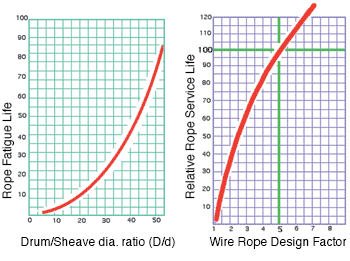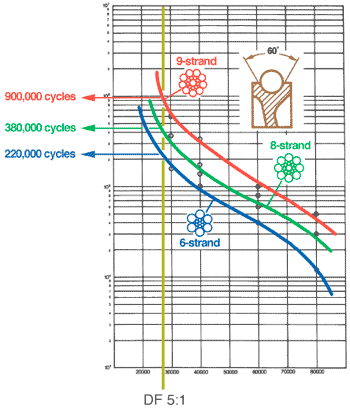PYTHON® Bending Fatigue Resistance & Rope Service Life

|
Bending Fatigue ResistanceThe ability of wire rope to withstand repeated bending work over sheaves and onto drums is called ‘fatigue resistance’. This term describes the ultimate rope life based on the maximum mechanical fatigue resistance of the wire material used. This term does NOT describe the ability to withstand mechanical damages nor the crush resistance of any wire rope. The fatigue resistance of a wire rope is not time- but cycle dependent. Bending fatigue is the ability to withstand repeated bending over sheaves and drums. The ability to withstand a certain number of bending cycles is linked to equipment related factors, such as: • diameter, shape, and groove dimensions of sheaves and drums The larger the bending radii become, the higher is the expected fatigue life. Large drums and sheaves will reduce radial rope pressures. Reverse bends in the reeving system, especially within short distances, will have a major negative impact on rope life. |
|

6×19 Filler Research Institute for Material Handling, Institute of Technology, Rope diameter: 16 mm (5/8″) |
Rope Service LifeMany years of monitoring rope performance in the field together with scientific research at Universities and Technical Institutes have led to the recognition that the number of outer strands in a rope is a very significant factor influencing rope service life. The number of outer strands determines the contact area between the rope and sheave groove. If this area is increased the points of contact are multiplied and abrasive wear of rope and sheave is reduced. At the same time lateral notching stresses between strands and wires are reduced, resulting in increased fatigue life. Extensive test programs at the University of Stuttgart, Germany, have proven conclusively that bending fatigue of wire rope improves with an increasing number of outer strands. Based on this research we have developed PYTHON® high performance wire rope with 8-, 9-, and 10 outer strands. |
|



